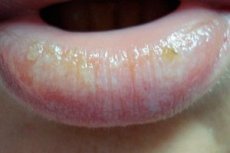Medical expert of the article
New publications
Exfoliative cheilitis
Last reviewed: 04.07.2025

All iLive content is medically reviewed or fact checked to ensure as much factual accuracy as possible.
We have strict sourcing guidelines and only link to reputable media sites, academic research institutions and, whenever possible, medically peer reviewed studies. Note that the numbers in parentheses ([1], [2], etc.) are clickable links to these studies.
If you feel that any of our content is inaccurate, out-of-date, or otherwise questionable, please select it and press Ctrl + Enter.

Exfoliative cheilitis manifests itself in two forms: exudative and dry.
ICD-10 code
By 13.02 Exfoliative cheilitis.
Exudative exfoliative cheilitis
This is a chronic disease of the lips, characterized by a persistent, long-term course.
What causes exfoliative cheilitis?
The etiology of the disease is unknown, but neurogenic, psychoemotional, immunological, endocrine and hereditary factors play a certain role. The thyroid gland plays an important role in the pathogenesis of the disease. This form most often affects women aged 20-40 years.
Symptoms
Exfoliative cheilitis can affect both lips, but is more often localized only on the lower one. The lips are swollen and enlarged. Patients are bothered by a burning sensation and pain in the lips, especially when they close, which makes it difficult to eat and speak; they always keep their mouths half-open.
The vermilion border of the lips is bright red, covered with a large number of moist scales and crusts soaked with exudate, due to which the crusts acquire a yellowish-gray color. A pyogenic infection may be present, which gives the crusts a yellow-honey color. With significant exudation, the crusts cover the lip in a continuous mass from corner to corner of the mouth, hanging like an apron on the chin. The process never spreads to the skin, localizing strictly from the mucous membrane of the transition zone of the lip (Klein's zone) to the middle of the vermilion border. Constantly forming crusts on the vermilion border of the lips reach their maximum development on the 3-6th day. Under the crusts, a bright red, moist, intact surface of the vermilion border of the lip is exposed. There are no erosions. The course of the disease is chronic, characterized by monotony and monomorphism.
How to recognize exfoliative cheilitis?
Diagnosis of the disease is based on the characteristic clinical picture - strictly limited localization of the lesion, absence of erosion and long course.
Histological examination reveals acanthosis, “empty” cells in the spinous layer, para- and hyperkeratosis with loss of connection between the cells of the spinous and horny layers.
Differential diagnostics
Exudative exfoliative cheilitis should be differentiated from eczematous cheilitis, pemphigus, actinic cheilitis (exudative form).
Eczematous cheilitis is characterized by the presence of erosions, blisters, and oozing. Eczema affects not only the red border of the lips, but also the skin.
In acantholytic pemphigus, after removing crusts from the lip, a bleeding erosion is revealed. At the same time, there may be manifestations of pemphigus in the oral cavity and on the skin of the body. Nikolsky's symptom is positive. Acantholytic cells are detected in scrapings from the lesion.
In actinic cheilitis (exudative form), the process on the lips is sharply aggravated by the influence of sunlight, which is not typical for exfoliative cheilitis. Dense scales in actinic cheilitis are difficult to separate when scraped, erosions may form.
Dry exfoliative cheilitis
Dry exfoliative cheilitis is clinically significantly different from the exudative form.
How does exfoliative cheilitis manifest itself?
On the dry surface of the red border of the lips, stagnant hyperemia occurs, dry translucent scales are formed, resembling mica plates, tightly fixed in the center. Patients are bothered by dryness, slight burning and tightening of the lips, a feeling of numbness is possible. Many scales in the form of a ribbon are located from corner to corner of the mouth, leaving the commissures free, located only from the Klein line to the middle of the red border of the lip. After removing the scales (they are removed quite easily), a bright red, intact surface of the red border of the lip is exposed.
Dry exfoliative cheilitis is characterized by a long, monotonous course, without a period of remission, but there are cases of sudden exacerbation of the disease and its transition to an exudative form.
Differential diagnostics
Dry exfoliative cheilitis should be differentiated from meteorological, atopic cheilitis and from the dry form of actinic cheilitis.
In meteorological cheilitis, the entire surface of the lip is affected. The exacerbation of the disease depends on various meteorological factors.
Atopic cheilitis manifests itself in the corners of the mouth and the adjacent red border of the lips and skin. Atopic cheilitis is characterized by lichenification of the skin in the corners of the mouth.
In the dry form of actinic cheilitis, the entire lip is involved in the process, in contrast to exfoliative cheilitis, which has a strictly limited localization.
Treatment of exfoliative cheilitis
Exfoliative cheilitis causes profound disorders of the nervous system in patients (usually young women), so treatment is carried out in conjunction with a neurologist or psychologist; consultation with an endocrinologist is recommended.
The general treatment plan includes sedatives (novo-passit), tranquilizers (diazepam, phenazepam), and in severe depressive states, antidepressants (amitriptyline, pipofezin) are prescribed. Anti-anxiety drugs (loratadine, desloratadine, and others), and vitamins B and C in therapeutic doses are indicated.
Treatment for the dry form includes vitamins A, E (orally), fatty creams (Radevit, Irikar). Acupuncture is indicated.
For the treatment of the exudative form, Bucky therapy (soft X-ray boundary rays) is used according to the scheme: initial dose of 1 Gy - 1 time per week, then 2-3 Gy with an interval of 7-10 days. The course dose is from 10-12 to 20 Gy.
The prognosis is favorable. After Bukka therapy, a complete and long-term remission will occur. In the dry form, treatment is ineffective, the course is long, many years.


 [
[